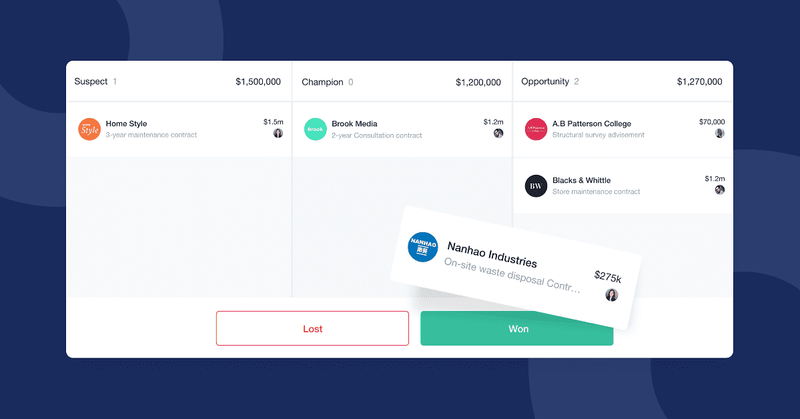A sales pipeline is a window into your future deals.
Once you have visibility of all your sale opportunities, you're more likely to hit your revenue targets and improve your bottom line. But if you're new to sales and never heard of a sales pipeline, here's all you need to know.
What does a sales pipeline do
A sales pipeline maps out each stage of your sales process in a simple way. It's used to track each deal through every step.
The sales pipeline shows you everyone interested in buying your product or service. So by tracking each deal through the sales process, you can easily forecast sales revenue.
Do you need a sales pipeline?
The simple answer is yes. It doesn’t have to be anything fancy, but if you run a business it’s crucial to see where all the money sits. Without knowing how many potential deals are coming in and how long they’ll take to convert, it’s difficult to assess the future profitability of your business.
But when you can see where each deal is sat in your sales process, you can easily forecast the sales revenue for the month ahead.
The further along the deals are in your sales pipeline, the higher the chance of you winning the sale so you can forecast a profitable month. Alternatively, if most of your deals are at the beginning of the cycle, and take an average of 60 days to win, you can forecast a low sales month and put in measures to improve profitability.
You can’t fix what you can’t see
A sales pipeline gives you great insight into each potential sale and the capability of your sales team. When you track each deal, you can easily see how long each salesperson takes to close one. You can immediately see if any of their deals get stuck in the process and how many are lost or convert into a sale.
This data will give you deep insight into each salesperson’s abilities and allow you to support those with a slow or small pipeline. Without this knowledge it’s difficult to spot issues before it’s too late.
How to set up a sales pipeline
As your sales pipeline is based on your sales process it will be unique to your business. To understand each stage of your sales process it's best to chat with those who sell your product or services as they'll instinctively know the detail.
1. Define the stages of the sales pipeline
Businesses tend to have between five and eight stages but you can have as many as you need. A six stage sales process could look like this:
- Lead (There's an interest in your product or service.)
- Qualified opportunity (You've confirmed a genuine interest in purchasing your product or service.)
- Initial Meeting (You’ve met and spotted a clear opportunity to satisfy their needs.)
- Proposal (You’ve presented a clear proposal on how you can meet their needs.)
- Verbal agreement (You've had verbal confirmation to purchase your product or service.)
- Close won (The deal is won.)
Here’s an example of how this pipeline would look in Capsule.

2. Weight each stage of the sales process
Once you've mapped out each stage, it’s useful to weight each one based on the probability of winning the deal.
Naturally you'll weight the earlier stages less than the later ones as a person isn't as committed in the beginning of the sales process. As they move through the sales pipeline they'll show more positive signs of purchasing so the weighting will increase.
When you run a forecast, this weighting can be key as you can forecast those deals with over a 50% chance of converting instead of them all. This improves the accuracy of your report.
So in the example above, the weighted sales pipeline could look like this:
- Lead (3%)
- Qualified opportunity (10%)
- Initial Meeting (30%)
- Proposal (65%)
- Verbal agreement (80%)
- Close won (100%)
3. Track sales momentum
It’s important to consider how often a salesperson should be interacting with someone at each stage of their pipeline in order to successfully nurture them to a sale.
This may differ substantially for each stage. In the beginning, you may contact people frequently to maintain interest. But as you get further down the pipeline, you'll probably give people more space so they have time to discuss your proposal with key decision makers.
Once you have a feel for how often a salesperson should contact their prospective clients at each stage, you can add this metric to your pipeline.
4. Fill your pipeline
A successful business will have a constant stream of deals filling the pipeline and moving through the sales cycle.
All opportunities in the pipeline won't convert to a sale (unless you're very lucky), you may find it's just 30%. If this is the case, you need to ensure your pipeline has enough deals in each stage of the process to help you reach your sales target.
It’s a constant juggling act for every salesperson to balance closing deals with filling the pipeline. But as your business grows and you build a strong reputation, your sales pipeline will start to fill with minimum effort as you'll benefit from positive word of mouth and referrals.
Manage your sales pipeline effectively
Your pipeline is only as good as the information in it. Sales forecasts can be over or under inflated and cause frustration if salespeople don’t manage their pipeline effectively.
Having clearly defined stages of your sales process in the pipeline will help but it's equally important for salespeople to update their pipeline regularly and use it correctly. Here are 10 tips on managing a sales pipeline.
Your sales pipeline will naturally adapt as you grow, it’s not something you set once and leave forever. Don't forget to review and reflect on your process once it's up and running; you'll get more value from the data if you do.
If you’re looking for an easy way to set up and manage a sales pipeline sign up to a free trial of Capsule.




